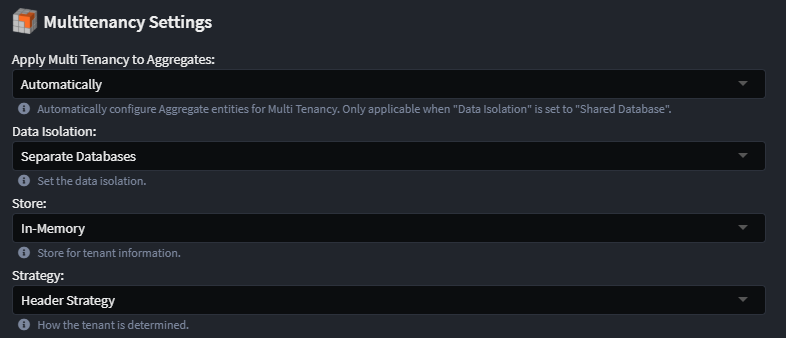Intent.AspNetCore.MultiTenancy
This module brings in support for Multi Tenancy through the use of FinBuckle.
What is Finbuckle?
Finbuckle.MultiTenant is open source multitenancy middleware library for .NET. It enables tenant resolution, per-tenant app behavior, and per-tenant data isolation. For more details check out the official documentation.
What's in this module?
This module generates the following as part of the Finbuckle implementation implementation:
- DI Container wiring.
- Finbucke configuration.
- Swashbucke integration.
- Entity Framework Core Integration.
Modules Settings
The following settings are available under the Multitenancy Settings section in Application Settings:

Strategy
This setting configures the Finbuckle MultiTenant Strategy, i.e how the tenant is identified per request. The available strategies are :
Header Strategy, identifies the tenant from a HTTP request header.Claim Strategy, identifies the tenant from a Claim.Host Strategy, identifies the tenant from the host name.Route Strategy, identifies the tenant from theRoute Strategy Parameterin the URL.
For more information on MultiTenant Strategies.
Store
Configures where tenant information is stored. The available options are :
Configuration, uses an app's configuration as the underlying store. Most of the sample projects use this store for simplicity. This store is case insensitive when retrieving tenant information by tenant identifier.Entity Framework Core, uses an Entity Framework Core database context as the backing store. This store is usually case-sensitive when retrieving tenant information by tenant identifier, depending on the underlying database.HTTP Remote, Sends the tenant identifier, provided by the multitenant strategy, to an http(s) endpoint to get a TenantInfo object in return.In-Memory, uses a ConcurrentDictionary<string, TenantInfo> as the underlying store.
For more information on stores.
Data Isolation
Configures your data isolation policy. The available options are :
Separate Databases, Each tenant is routed to their own database which contains only their data.Shared Database, A single database is used and tenant data is segregated at a row level through the use of TenantId columns.
Apply Multi Tenancy to Aggregates
When using Shared Database data isolation option you need to indicate which data is tenant specific and which data is not. This is done be applying the Multi Tenant stereotype to Tenant specify aggregate roots. This setting controls wether or not the Domain Designer automatically adds this Stereotype to all new Entities or the not.
The available options are :
Automatically, Each newly addedClassin the domain designer will have theMulti Tenantstereotype applied.Manually, theMulti Tenantmust be manually applied where required.
Route Strategy Parameter
The route paramter name which can be used in the Services Designer to define where and how the tenant information is included in the route. Default value is __tenant__.
For example, having the Strategy set to Route Strategy with a Route Strategy Parameter value of __tenant__, allows Route values on Commands, Queries and Services to contain the {__tenant__} placeholder.
DI Container wiring
Wire Finbuckle into your dependency injection and application configuration code.
public void ConfigureServices(IServiceCollection services)
{
...
services.ConfigureMultiTenancy(Configuration);
...
}
public void Configure(IApplicationBuilder app, IWebHostEnvironment env)
{
...
app.UseRouting();
app.UseMultiTenancy();
...
}
Tenant Info Injection
The current tenant information, as well as information on all tenants (via the store) can be injected into the relevant class, using the dependency injection container:
Current Tenant Info
ITenantInfo can be injected into the relevant class, which will provide access to information about the current tenant:
public CreateProductCommandHandler(IProductRepository productRepository, ITenantInfo tenantInfo)
{
_productRepository = productRepository;
_tenantInfo = tenantInfo;
}
All Tenants
If access to all tenants is required, then IMultiTenantStore<TenantInfo> can be injected:
public CreateProductCommandHandler(IProductRepository productRepository, IMultiTenantStore<TenantInfo> tenantStore)
{
_productRepository = productRepository;
_tenantStore = tenantStore;
}
Finbucke configuration
Setup and configure Finbuckle inline with your configured settings.
public static class MultiTenancyConfiguration
{
public static IServiceCollection ConfigureMultiTenancy(
this IServiceCollection services,
IConfiguration configuration)
{
services.AddMultiTenant<TenantInfo>()
.WithInMemoryStore(SetupInMemoryStore) // See https://www.finbuckle.com/MultiTenant/Docs/v6.12.0/Stores#in-memory-store
.WithHeaderStrategy("X-Tenant-Identifier"); // See https://www.finbuckle.com/MultiTenant/Docs/v6.12.0/Strategies#header-strategy
return services;
}
public static void UseMultiTenancy(this IApplicationBuilder app)
{
app.UseMultiTenant();
InitializeStore(app.ApplicationServices);
}
//In-Memory Store Configuration
[IntentManaged(Mode.Fully, Body = Mode.Ignore)]
private static void SetupInMemoryStore(InMemoryStoreOptions<TenantInfo> options)
{
// configure in memory store:
options.IsCaseSensitive = false;
}
[IntentManaged(Mode.Fully, Body = Mode.Ignore)]
public static void InitializeStore(IServiceProvider sp)
{
var scopeServices = sp.CreateScope().ServiceProvider;
var store = scopeServices.GetRequiredService<IMultiTenantStore<TenantInfo>>();
store.TryAddAsync(new TenantInfo() { Id = "sample-tenant-1", Identifier = "tenant1", Name = "Tenant 1", ConnectionString = "Tenant1Connection" }).Wait();
store.TryAddAsync(new TenantInfo() { Id = "sample-tenant-2", Identifier = "tenant2", Name = "Tenant 2", ConnectionString = "Tenant2Connection" }).Wait();
}
}
Swashbucke integration
Configure Swashbuckle to include support for Tenancy.
public class TenantHeaderOperationFilter : IOperationFilter
{
public void Apply(OpenApiOperation operation, OperationFilterContext context)
{
if (operation.Parameters == null)
{
operation.Parameters = new List<OpenApiParameter>();
}
operation.Parameters.Add(new OpenApiParameter
{
Name = "X-Tenant-Identifier",
In = ParameterLocation.Header,
Description = "Tenant Id",
Required = true
});
}
}
Entity Framework Core Integration
Introduce Multi Tenant concepts in the DbContext class and Entity Configurations.
Note
In order to create and update EF Core migration scripts against a Finbuckle-managed application, you will need to make use of the Intent.Modules.EntityFrameworkCore.DesignTimeDbContextFactory module. More information can be found here.
Both your API project and Infrastructure project's appsettings.json will need to be kept in sync when tenant database connection strings are updated.
public class ApplicationDbContext : DbContext, IUnitOfWork, IMultiTenantDbContext
{
private readonly IDomainEventService _domainEventService;
public ApplicationDbContext(DbContextOptions<ApplicationDbContext> options,
ITenantInfo tenantInfo) : base(options)
{
TenantInfo = tenantInfo;
}
public ITenantInfo TenantInfo { get; private set; }
public TenantMismatchMode TenantMismatchMode { get; set; } = TenantMismatchMode.Throw;
public TenantNotSetMode TenantNotSetMode { get; set; } = TenantNotSetMode.Throw;
...
public override async Task<int> SaveChangesAsync(
bool acceptAllChangesOnSuccess,
CancellationToken cancellationToken = default)
{
this.EnforceMultiTenant();
...
}
public override int SaveChanges(bool acceptAllChangesOnSuccess)
{
this.EnforceMultiTenant();
...
}
}